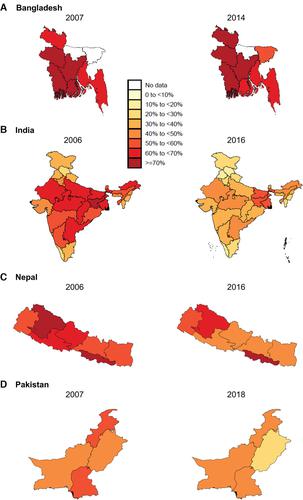当前位置:
X-MOL 学术
›
Ann. N. Y. Acad. Sci.
›
论文详情
Our official English website, www.x-mol.net, welcomes your feedback! (Note: you will need to create a separate account there.)
Early marriage and early childbearing in South Asia: trends, inequalities, and drivers from 2005 to 2018
Annals of the New York Academy of Sciences ( IF 5.2 ) Pub Date : 2020-12-01 , DOI: 10.1111/nyas.14531 Samuel Scott 1, 2 , Phuong Hong Nguyen 1 , Sumanta Neupane 2 , Priyanjana Pramanik 2 , Priya Nanda 3 , Zulfiqar A Bhutta 4 , Kaosar Afsana 5 , Purnima Menon 1, 2
Annals of the New York Academy of Sciences ( IF 5.2 ) Pub Date : 2020-12-01 , DOI: 10.1111/nyas.14531 Samuel Scott 1, 2 , Phuong Hong Nguyen 1 , Sumanta Neupane 2 , Priyanjana Pramanik 2 , Priya Nanda 3 , Zulfiqar A Bhutta 4 , Kaosar Afsana 5 , Purnima Menon 1, 2
Affiliation

|
Early marriage (EM) and early childbearing (ECB) have far-reaching consequences. This study describes the prevalence, trends, inequalities, and drivers of EM and ECB in South Asia using eight rounds of Demographic and Health Survey data across 13 years. We report the percentage of ever-married women aged 20-24 years (n = 105,150) married before 18 years (EM) and with a live birth before 20 years (ECB). Relative trends were examined using average annual rate of reduction (AARR). Inequalities were examined by geography, marital household wealth, residence, and education. Sociodemographic drivers of changes for EM were assessed using regression decomposition analyses. We find that EM/ECB are still common in Bangladesh (69%/69%), Nepal (52%/51%), India (41%/39%), and Pakistan (37%/38%), with large subnational variation in most countries. EM has declined fastest in India (AARR of -3.8%/year), Pakistan (-2.8%/year), and Bangladesh (-1.5%/year), but EM elimination by 2030 will not occur at these rates. Equity analyses show that poor, uneducated women in rural areas are disproportionately burdened. Regression decomposition analysis shows that improvements in wealth and education explained 44% (India) to 96% (Nepal) of the actual EM reduction. Investments across multiple sectors are required to understand and address EM and ECB, which are pervasive social determinants of maternal and child wellbeing.
中文翻译:

南亚的早婚早育:2005 年至 2018 年的趋势、不平等和驱动因素
早婚(EM)和早育(ECB)具有深远的影响。本研究使用 13 年来的八轮人口和健康调查数据描述了南亚新兴市场和欧洲央行的流行情况、趋势、不平等和驱动因素。我们报告了 20-24 岁的已婚女性 (n = 105,150) 在 18 岁之前结婚 (EM) 和在 20 岁之前活产 (ECB) 的百分比。使用平均年减少率(AARR)检查相对趋势。通过地理、婚姻家庭财富、居住地和教育来考察不平等现象。使用回归分解分析评估了新兴市场变化的社会人口学驱动因素。我们发现,新兴市场/欧洲央行在孟加拉国(69%/69%)、尼泊尔(52%/51%)、印度(41%/39%)和巴基斯坦(37%/38%)仍然很常见,并且有大量次国家大多数国家的差异。新兴市场下降最快的是印度(年增长率为-3.8%/年)、巴基斯坦(-2.8%/年)和孟加拉国(-1.5%/年),但新兴市场不会以这些速度在 2030 年被淘汰。公平分析表明,农村地区贫穷、未受过教育的妇女承受着不成比例的负担。回归分解分析表明,财富和教育的改善解释了新兴市场实际减少的 44%(印度)至 96%(尼泊尔)。需要跨多个部门进行投资来了解和解决新兴市场和欧洲央行问题,它们是孕产妇和儿童福祉的普遍社会决定因素。
更新日期:2020-12-01
中文翻译:

南亚的早婚早育:2005 年至 2018 年的趋势、不平等和驱动因素
早婚(EM)和早育(ECB)具有深远的影响。本研究使用 13 年来的八轮人口和健康调查数据描述了南亚新兴市场和欧洲央行的流行情况、趋势、不平等和驱动因素。我们报告了 20-24 岁的已婚女性 (n = 105,150) 在 18 岁之前结婚 (EM) 和在 20 岁之前活产 (ECB) 的百分比。使用平均年减少率(AARR)检查相对趋势。通过地理、婚姻家庭财富、居住地和教育来考察不平等现象。使用回归分解分析评估了新兴市场变化的社会人口学驱动因素。我们发现,新兴市场/欧洲央行在孟加拉国(69%/69%)、尼泊尔(52%/51%)、印度(41%/39%)和巴基斯坦(37%/38%)仍然很常见,并且有大量次国家大多数国家的差异。新兴市场下降最快的是印度(年增长率为-3.8%/年)、巴基斯坦(-2.8%/年)和孟加拉国(-1.5%/年),但新兴市场不会以这些速度在 2030 年被淘汰。公平分析表明,农村地区贫穷、未受过教育的妇女承受着不成比例的负担。回归分解分析表明,财富和教育的改善解释了新兴市场实际减少的 44%(印度)至 96%(尼泊尔)。需要跨多个部门进行投资来了解和解决新兴市场和欧洲央行问题,它们是孕产妇和儿童福祉的普遍社会决定因素。


























 京公网安备 11010802027423号
京公网安备 11010802027423号